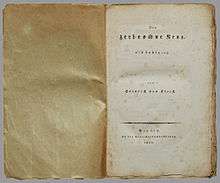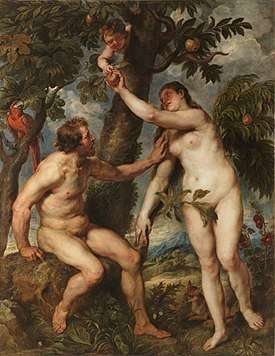The Broken Jug
The Broken Jug (German: Der zerbrochne Krug, pronounced [deːɐ̯ t͡sɛɐ̯.ˈbʁɔx.nə kʁuːk] (![]()
| The Broken Jug | |
|---|---|
 First edition 1811 | |
| Written by | Heinrich von Kleist |
| Characters | Adam, Eve, Licht, Walter, Frau Marthe, Ruprecht |
| Date premiered | 2 March 1808 |
| Original language | German |
The Broken Jug mocks the failings of human nature and the judicial system in a forgiving way. It is similar to Sophocles' tragedy Oedipus Rex (c. 429 BCE), in that in both plays the judge is guilty, but different insofar as Adam knows from the start who is guilty, as does the audience, and is trying his hardest to conceal the truth.
The play follows the story of "Adam" and "Eve". Adam is covered in various injuries and talking with his secretary Licht. The jug is not mentioned in these first five scenes although the audience is made aware that Adam is a highly suspicious character. The trial lasting from scene seven through to scene eleven, shows the characters on stage trying to piece together the events which led to the breaking of the jug. At the end of scene eleven Eve states that Adam broke the jug and Adam escapes in the confusion.
Characters
- Adam – the judge. He is the one who broke the jug. He became attracted to Eve and in order to make her cooperate with his desires he made up a story about Ruprecht being conscripted into the army.
- Eve – a simple but honest country girl. She knows who broke the jug but does not say so until he directly threatens Ruprecht whom she loves.
- Licht – the judge's secretary. He is mysterious and portrayals of him vary. He uncovers the truth but cleverly allows Adam to condemn himself rather than openly accusing him.
- Walter – the man who comes to inspect Adam and the way he runs his court.
- Frau Marthe – Eve's mother.
- Ruprecht – a young man who is in love with Eve.
Motifs/symbols/themes
- The broken jug – This central image which gives the play its title is intimately bound up with the idea that with the breaking of the jug, Eve's chastity has been lost, an idea which comes from a German phrase, Kleist making the link quite literal. This explains why such a seemingly insignificant object becomes so significant in the eyes of the courtroom. Only Adam and Eve know who broke the jug, and neither reveal the truth until Adam sentences Ruprecht to prison, when she says decisively, "Judge Adam smashed the jug." The audience has been aware throughout the play who is guilty.
- Comedy – This is the only piece of work which Kleist wrote which is pure comedy. Most of the humour is based on word play and the ludicrous ideas which are presented.
- Truth – Kleist became intrigued by the Kantian idea of being unable to know what is really real. The play shows the contradicting ideas that what is real is what you can see and touch (as represented by Ruprecht) and that appearances might be deceptive and that there might be a deeper truth (as represented by Eve).
- Justice and the judicial system – Adam is both the criminal and the judge.
- The periwig – Adam has lost his periwig after having to escape from Eve's bedroom window. It represents his role as the judge.
- Rural life – The village where the events take place is small and the inhabitants look to Adam as the ultimate authority. The idea that he could be guilty only occurs to Walter, the outsider, and Licht, the intelligent secretary.
- Symbolic Names – The names of the characters are highly symbolic, Adam and Eve, in reference to the Fall and the idea of temptation. The play opposes the original fall however in that it is the man, Adam, who is corrupt and has corrupted the innocent Eve. Licht ("Light") uncovers the truth about the breaking of the jug subtly, bringing light, metaphorically, to the situation.
Adaptations
In 1937 a German film of the same title was released with Emil Jannings in the lead. It is also a 1941 opera by Viktor Ullmann. In 1944 it was produced as a film in Mexico by German director Alfredo B. Crevenna under the title Adan, Eva y el diablo.[4] In 1958, the Stratford Festival produced an adaptation by Donald Harron and directed by Michael Langham which toured in Canada and to the Phoenix Theatre in New York.[5][6] The Irish author, John Banville, adapted the play, setting it in a famine-stricken Irish village. [7] It had its first production in Dublin in 1994.[8]. In Indonesia, Studiklub Teater Bandung (STB) produced adaption by Suyatna Anirun with Indonesian title "Jambangan yang Pecah" in 1982.[9]
References
- Banham (1998, 603).
- Helbling (1975, 120).
- Banham (1998, 603) and Helbling (1975, 120).
- Adan, Eva y el diablo on IMDb
- "The Broken Jug (1958) production credits". Stratford Festival Archives. Retrieved 2019-06-26.
- Whittaker, Herbert (22 February 1958), "The Broken Jug? Mr. Harron is All Innocence", The Globe and Mail, p. 13
- Banville, John, The Broken Jug, Gallery Books (1994).
- http://www.irishplayography.com/play.aspx?playid=31063
- "Misteri di Balik Jambangan Pecah". KORAN SINDO. Retrieved 2019-09-21.
Sources
- Banham, Martin, ed. 1998. The Cambridge Guide to Theatre. Cambridge: Cambridge University Press. ISBN 0-521-43437-8.
- Helbling, Robert. 1975. The Major Works of Heinrich von Kleist. New York: New Directions. ISBN 0-8112-0563-0.
- Lamport, Francis John. 1990. German Classical Drama: Theatre, Humanity and Nation, 1750–1870. Cambridge: Cambridge University Press. ISBN 0-521-36270-9.
